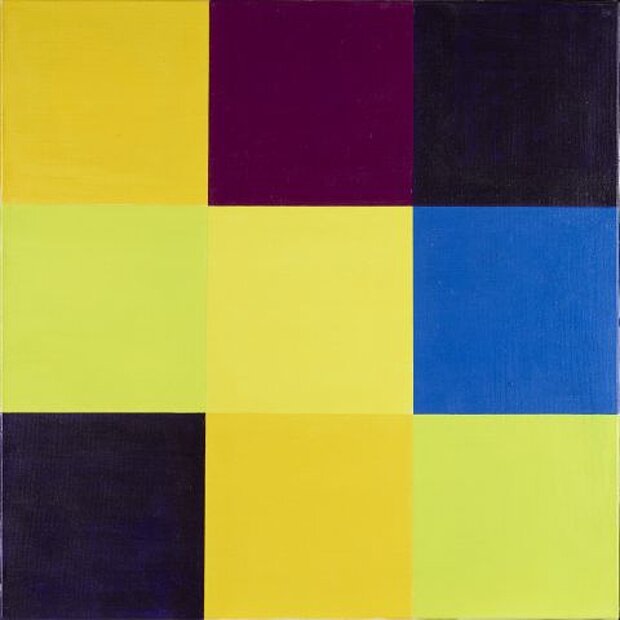
Lohse, Richard Paul
Ordnung aus Gleichung und Kontrast
Arrangement of Similarity and Contrast
1952 - 1982

© mumok
| Object description | Acrylic on canvas |
|---|---|
| Object category | painting |
| Material |
Object:
acrylic paint
Support:
canvas
|
| Technique |
Object:
acrylic painting
|
| Dimensions |
Object:
height: 48 cm,
width: 48 cm,
depth: 2 cm
Frame:
height: 53,8 cm,
width: 53,8 cm,
depth: 3,3 cm
|
| Year of acquisition | 2007 |
| Inventory number | MB 39/0 |
| Creditline | Sammlung Dieter und Gertraud Bogner im mumok |
| Rights reference | Bildrecht, Wien |
| Further information about the person | Lohse, Richard Paul [GND] |
| Literature |
Leidenschaftlich Exakt.Sammlung Dieter und Gertraud Bogner im mumok Genau und anders :Mathematik in der Kunst von Dürer bis Sol LeWitt |
Nine color fields arranged on a square canvas. Is there a system? Is this pure poetry? For Richard Paul Lohse it is both. Two sun-gold, two bright green and four violet and four blue shapes are arranged around a central square. At first sight there is no clear method to their arrangement, but after a closer look our gaze is caught in a smooth rhythmical movement between the different color fields. Lohse does not limit his color scale to the primary colors. He selects color tones that are similar or close to each other and he sees a dynamic quality between these color tones. The eye automatically looks for the corresponding shape—as a similar shape or a contrasting one. Lohse generated these pictures in series, but not based on a preconceived and inflexible scheme. His painterly decisions are always attempts to balance out our visual impressions. The strict formal division of the surface of the picture into squares is always the basis for the greatest possible balance between the various elements used in the image. Lohse gave this work the title “System of Comparison and Contrast.” He always chose a small format of 48 by 48 centimeters for pictures he gave as gifts to friends and acquaintances. On the back of this picture he noted: 867 For Gertraud + Dieter Bogner Richard Paul Lohse / August 83. The Swiss painter and graphic artist began back in the 1940s to work with modular and serial arrangements. His search for visual balance in his pictures corresponds to his thoughts on social utopias and cultural theory in his texts. Lohse’s concept of “analogue” structures in art and society aims at a new understanding of non-mimetic art generating knowledge.
© mumok – museum moderner kunst stiftung ludwig wien